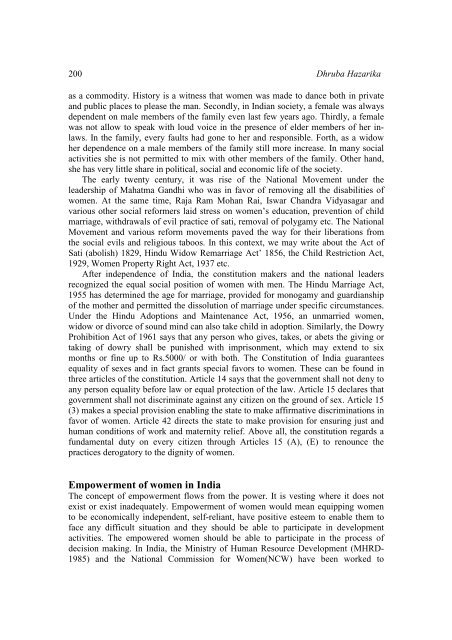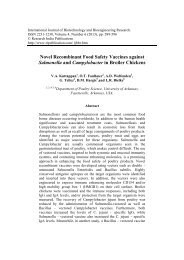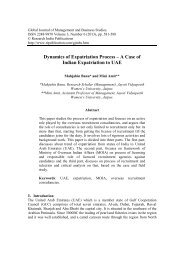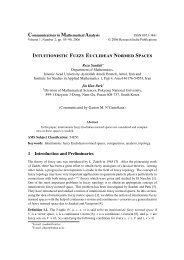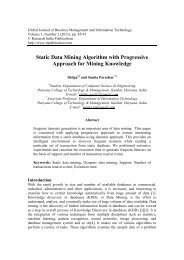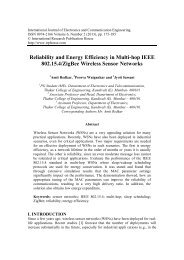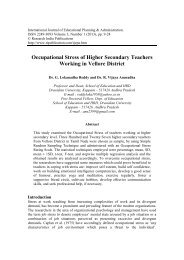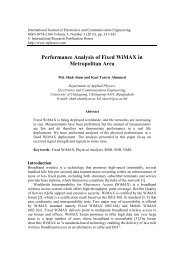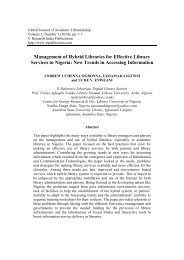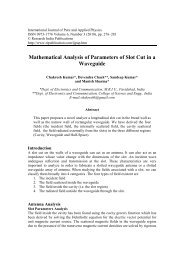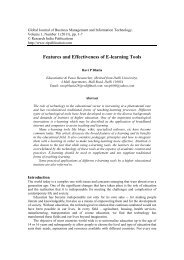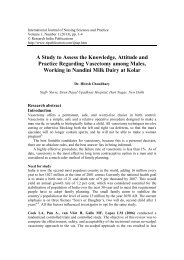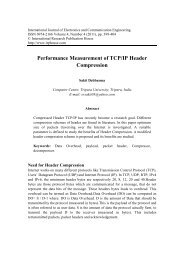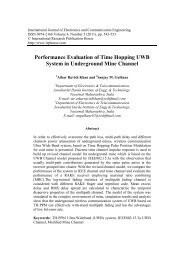Women Empowerment in India: A Brief Discussion - Research India ...
Women Empowerment in India: A Brief Discussion - Research India ...
Women Empowerment in India: A Brief Discussion - Research India ...
Create successful ePaper yourself
Turn your PDF publications into a flip-book with our unique Google optimized e-Paper software.
200 Dhruba Hazarika<br />
as a commodity. History is a witness that women was made to dance both <strong>in</strong> private<br />
and public places to please the man. Secondly, <strong>in</strong> <strong>India</strong>n society, a female was always<br />
dependent on male members of the family even last few years ago. Thirdly, a female<br />
was not allow to speak with loud voice <strong>in</strong> the presence of elder members of her <strong>in</strong>laws.<br />
In the family, every faults had gone to her and responsible. Forth, as a widow<br />
her dependence on a male members of the family still more <strong>in</strong>crease. In many social<br />
activities she is not permitted to mix with other members of the family. Other hand,<br />
she has very little share <strong>in</strong> political, social and economic life of the society.<br />
The early twenty century, it was rise of the National Movement under the<br />
leadership of Mahatma Gandhi who was <strong>in</strong> favor of remov<strong>in</strong>g all the disabilities of<br />
women. At the same time, Raja Ram Mohan Rai, Iswar Chandra Vidyasagar and<br />
various other social reformers laid stress on women’s education, prevention of child<br />
marriage, withdrawals of evil practice of sati, removal of polygamy etc. The National<br />
Movement and various reform movements paved the way for their liberations from<br />
the social evils and religious taboos. In this context, we may write about the Act of<br />
Sati (abolish) 1829, H<strong>in</strong>du Widow Remarriage Act’ 1856, the Child Restriction Act,<br />
1929, <strong>Women</strong> Property Right Act, 1937 etc.<br />
After <strong>in</strong>dependence of <strong>India</strong>, the constitution makers and the national leaders<br />
recognized the equal social position of women with men. The H<strong>in</strong>du Marriage Act,<br />
1955 has determ<strong>in</strong>ed the age for marriage, provided for monogamy and guardianship<br />
of the mother and permitted the dissolution of marriage under specific circumstances.<br />
Under the H<strong>in</strong>du Adoptions and Ma<strong>in</strong>tenance Act, 1956, an unmarried women,<br />
widow or divorce of sound m<strong>in</strong>d can also take child <strong>in</strong> adoption. Similarly, the Dowry<br />
Prohibition Act of 1961 says that any person who gives, takes, or abets the giv<strong>in</strong>g or<br />
tak<strong>in</strong>g of dowry shall be punished with imprisonment, which may extend to six<br />
months or f<strong>in</strong>e up to Rs.5000/ or with both. The Constitution of <strong>India</strong> guarantees<br />
equality of sexes and <strong>in</strong> fact grants special favors to women. These can be found <strong>in</strong><br />
three articles of the constitution. Article 14 says that the government shall not deny to<br />
any person equality before law or equal protection of the law. Article 15 declares that<br />
government shall not discrim<strong>in</strong>ate aga<strong>in</strong>st any citizen on the ground of sex. Article 15<br />
(3) makes a special provision enabl<strong>in</strong>g the state to make affirmative discrim<strong>in</strong>ations <strong>in</strong><br />
favor of women. Article 42 directs the state to make provision for ensur<strong>in</strong>g just and<br />
human conditions of work and maternity relief. Above all, the constitution regards a<br />
fundamental duty on every citizen through Articles 15 (A), (E) to renounce the<br />
practices derogatory to the dignity of women.<br />
<strong>Empowerment</strong> of women <strong>in</strong> <strong>India</strong><br />
The concept of empowerment flows from the power. It is vest<strong>in</strong>g where it does not<br />
exist or exist <strong>in</strong>adequately. <strong>Empowerment</strong> of women would mean equipp<strong>in</strong>g women<br />
to be economically <strong>in</strong>dependent, self-reliant, have positive esteem to enable them to<br />
face any difficult situation and they should be able to participate <strong>in</strong> development<br />
activities. The empowered women should be able to participate <strong>in</strong> the process of<br />
decision mak<strong>in</strong>g. In <strong>India</strong>, the M<strong>in</strong>istry of Human Resource Development (MHRD-<br />
1985) and the National Commission for <strong>Women</strong>(NCW) have been worked to


